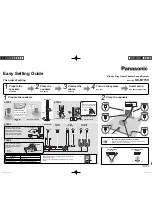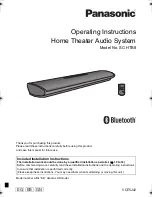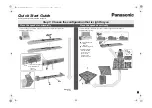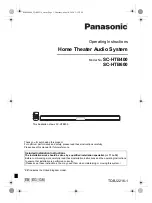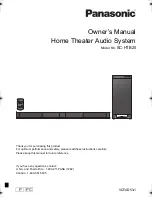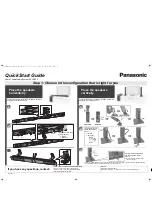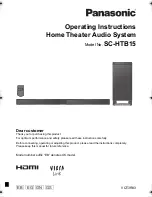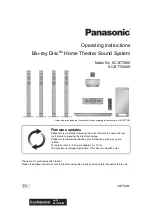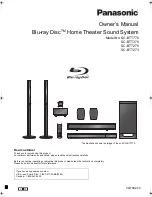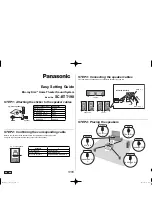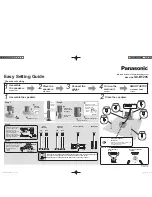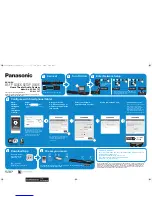
2
English
Bi-Wire Connection
This connection method replaces the jumper clips installed
under the binding posts with individual runs of speaker wire
from your amplifier. This doubles the signal carrying conductors
from the amplifier to the speaker, thus direct-coupling each por-
tion of the crossover to the amplifier.
To bi-wire you must first loosen the binding posts and remove
the jumper clips. Connect one set of wires to the upper set of
binding posts which connect to the panel. Then connect a sec-
ond set of wires to the lower binding posts which connect to
the woofer. Next, connect both sets of wires to the appropriate
terminals on your amplifier. Please take care to connect both
(+) wires to the (+) amplifier terminals and both (-) wires to the
(–) amplifier terminals. This is known as a parallel connection.
Passive Bi-Amplification
For those that desire ultimate performance, the speaker may
be passively bi-amplified using the existing internal passive
crossover elements.
WARNING!
Only after jumper clips are
removed may you connect individual runs of
speaker cable from your amplifiers to the high
pass (ESL) and low pass (WOOFER) signal input
binding posts. Damage will occur to your ampli-
fiers if the jumper clips are not removed.
This method takes the bi-wiring concept one step further.
You will have a dedicated channel of amplification directly
connected to the high and low pass sections of the crossover.
There are two different methods for bi-amping with two ste-
reo amplifiers. The first and most common is referred to as
Horizontal Bi-amping. The second method is referred to as
Vertical Bi-amping. With either method you may use two ste-
reo amplifiers or four mono amplifiers, or two mono amplifiers
and one stereo amplifier. Get the idea? With either form of
passive bi-amplification, your preamplifier must have dual out-
puts. If your preamplifier is not so equipped, you must either
purchase or construct a “Y” adapter.
Horizontal Passive Bi-Amplification
Horizontal bi-amping allows you to use two different types,
models or brands of amplifiers (i.e. tubes on top, transistor on
the bottom). However, we recommend that you use two iden-
tical amplifiers (i.e. same brand and model). If you must use
two different amplifiers, it is essential that they have the same
gain or that one of the two have adjustable gain so that you can
match their gain characteristics. If the amplifiers of choice do not
have the same gain characteristics, then a sonic imbalance will
occur. With horizontal bi-amping, one amplifier drives the high
pass (ESL) section while the second amplifier drives the low pass
(WOOFER) section. To horizontally bi-amp you must loosen
the binding posts and remove the jumper clips. Connect the
low frequency amplifier to the lower set of binding posts of both
speakers. Connect the high frequency amplifier to the upper set
of binding posts. Next, connect the left and right preamplifier
outputs to the appropriate left and right inputs of both amplifiers.
Vertical Passive Bi-Amplification
The very nature of vertical bi-amping dictates that both ampli-
fiers be identical. With vertical bi-amping, each of the stereo
amplifiers is dedicated to one speaker. For instance, the left
channel of each amplifier drives the low pass (WOOFER) sec-
tion while the right channel drives the high pass (ESL) section.
To vertically bi-amp your you must loosen the binding posts
and remove the jumper clips from both speakers. Starting with
one speaker, connect the right channel to the lower binding
posts and the left channel to the upper binding posts. Repeat
the same procedure for the other speaker. Connect the left
preamplifier outputs to both inputs of the left channel amplifi-
er and the right preamplifier outputs to both inputs of the right
channel amplifier.
Active Bi-Amplification
We do not recommend active bi-amplification. The internal
crossover can not be bypassed. This connection method seri-
ously degrades the performance.
Содержание 839ESL9CH
Страница 1: ......
Страница 2: ......
Страница 3: ......
Страница 4: ...u s e r s m a n u a l m a n u e l d e l u t i l i s a t e u r...
Страница 7: ......
Страница 9: ......
Страница 10: ...15 38cm 59 8 152cm 0 10 4 26 4cm 9 3 23 6cm 34Hz 23kHz 3dB 78 lbs 35 4 kg 4 Ohms 90dB 2 83 V M...
Страница 11: ...6 2 15 8cm 4 4 11 3cm 7 6 19 2cm 25 1 63 7cm 25 4 64 6cm 0 5 0 0...
Страница 12: ...2x x 8 20cm 24 61cm x...
Страница 13: ......
Страница 14: ...Classic ESL 9 50 400W 4 Ohms...
Страница 15: ......
Страница 16: ...u s e r s m a n u a l English...
Страница 17: ...42...
Страница 23: ...6 English 2x x 8 20cm 24 61cm x Final placement...
Страница 24: ...7 Flashlight toe in technique English...
Страница 41: ......































